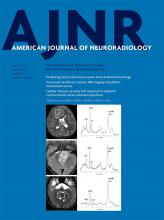Abstract
BACKGROUND AND PURPOSE: Cerebral aneurysms have significantly different rupture rates depending on their size and location. The mechanisms underlying these differences are unclear. We examined whether anatomic rupture risks are dependent on the hemodynamic environment on the aneurysmal surface.
MATERIALS AND METHODS: Patient-specific geometries and flow rates of 84 cerebral aneurysms (42 anterior communicating artery and 42 MCA aneurysms) were acquired from our clinical study, the Computational Fluid Dynamics Analysis of Blood Flow in Cerebral Aneurysms: Prospective Observational Study. Pulsatile blood flow was simulated to calculate hemodynamic metrics with special attention to wall shear stress magnitude and temporal disturbance. Multivariate analyses were performed to identify associations between hemodynamic metrics and known rupture predictors (age, sex, hypertension, smoking history, location, and size).
RESULTS: All the wall shear stress magnitude–based metrics showed a significant negative association with size and location (P < .03), but not other risk factors. All the wall shear stress disturbance–based metrics were significantly related to size (P < .001). Only normalized transverse wall shear stress, a metric for multidirectional wall shear stress disturbance, was related to location (P = .03). The normalized transverse wall shear stress had the highest odds ratio for location and size among hemodynamic metrics (odds ratios, 1.275 and 1.579; 95% confidence intervals, 1.020–1.693 and 1.238–2.219, respectively). Among the arterial geometric parameters, the aspect ratio had the second strongest association with all hemodynamic metrics, after our newly proposed aspect ratio–asphericity index.
CONCLUSIONS: The differences in aneurysm rupture rates according to size and location may reflect differences in hemodynamic environments in qualitatively different ways. An enhanced multidirectional wall shear stress disturbance may be especially associated with aneurysm rupture.
ABBREVIATIONS:
- AAI
- aspect ratio–asphericity index
- AcomA
- anterior communicating artery
- β
- regression coefficient
- CFD
- computational fluid dynamics
- GON
- gradient oscillatory number
- NtransWSS
- normalized transverse wall shear stress
- NWSS
- normalized wall shear stress
- NWSSG
- normalized wall shear stress gradient
- OSI
- oscillatory shear index
- TAWSS
- time-averaged wall shear stress
- TAWSSG
- time-averaged wall shear stress gradient
- WSS
- wall shear stress
- © 2019 by American Journal of Neuroradiology
Indicates open access to non-subscribers at www.ajnr.org












